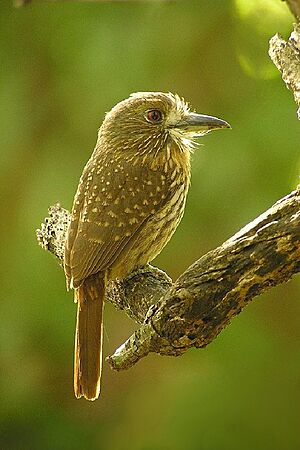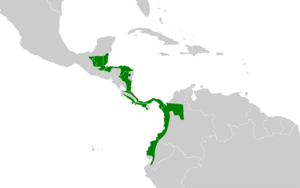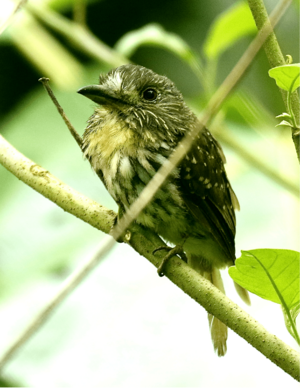White-whiskered puffbird facts for kids
Quick facts for kids White-whiskered puffbird |
|
|---|---|
 |
|
| Conservation status | |
| Scientific classification | |
| Genus: |
Malacoptila
|
| Species: |
panamensis
|
 |
|
The white-whiskered puffbird (Malacoptila panamensis) is a cool bird known for its fluffy feathers and, you guessed it, white whiskers! It's also sometimes called the white-whiskered soft-wing or brown puffbird. This bird belongs to a family called Bucconidae, which includes other puffbirds, nunlets, and nunbirds. You can find these birds in places like southeastern Mexico, across Central America (but not El Salvador), and down into Colombia, Ecuador, and Peru.
Contents
Bird Families and Types
The white-whiskered puffbird has four different types, called subspecies. They are a bit like different versions of the same bird, with small differences in their looks.
- M. p. inornata
- M. p. panamensis
- M. p. magdalenae
- M. p. poliopsis
Scientists think this puffbird is closely related to the moustached puffbird and the black-streaked puffbird. They might even be part of a "superspecies," which means they are very similar and probably came from a common ancestor.
What Does It Look Like?
The white-whiskered puffbird is about 18 centimeters (7 inches) long. It weighs around 43 grams (1.5 ounces), which is about the same as a few strawberries.
Unlike many birds, the male and female puffbirds look a bit different. Both have special bristles around their large beak and white "whiskers." These whiskers are actually tufts of feathers!
- Males: Their top feathers are brown to chestnut brown. They have light streaks on their head and spots on their back. Their tail is chestnut brown. Their face and neck sides are a tawny (light brownish-orange) color. Their throat and upper chest are also tawny, and the rest of their belly is white with darker streaks.
- Females: They are less chestnut-colored. Their head is grayer, and their top feathers are more olive to brown. Most of their belly is buff to cinnamon-buff with darker streaks, and their lower belly is white.
- Young Birds: They look similar to the females but have more streaks on their belly.
The different subspecies mostly vary in the exact shades of gray, brown, and reddish-brown, and how many streaks they have.
Where Do They Live?
These puffbirds live in different areas depending on their subspecies:
- M. p. inornata: Found along the Caribbean coast from southeastern Mexico, through Belize, Guatemala, Nicaragua, and Costa Rica, into western Panama.
- M. p. panamensis: Lives along the Pacific coast from southwestern Costa Rica, through Panama, into northwestern Colombia.
- M. p. magdalenae: Found in the Magdalena River valley in west-central Colombia.
- M. p. poliopsis: Lives from southwestern Colombia, through western Ecuador, into the very northwestern part of Peru.
These birds mostly live in thick, green forests that stay green all year. They can also be found in forests that are growing back after being cut down, and near the edges of fields. They usually stay close to the ground, within 6 meters (20 feet) of it. They can live from sea level up to about 750 meters (2,460 feet) high in Central America, and even higher in some parts of Costa Rica and Colombia, up to 1,200 meters (3,900 feet).
How They Live
Feeding Habits
Like other puffbirds, the white-whiskered puffbird is a patient hunter. It sits very still on a branch, watching. When it sees something, it quickly darts out to catch it. They mostly eat large invertebrates (like insects and spiders) and small vertebrates (like frogs and lizards). After catching its prey, the bird takes it back to its perch and hits it against the branch before eating it. These puffbirds have also been seen following swarms of army ants to catch insects disturbed by the ants. They sometimes join groups of different bird species that are all looking for food together.
Reproduction and Life Cycle
Most of what we know about the white-whiskered puffbird's breeding comes from studies in Costa Rica. Their breeding season there is from mid-March to July.
They build their nests in a burrow, which is a tunnel dug into the ground. The burrow is usually about 46 to 56 centimeters (18 to 22 inches) long and 6 centimeters (2.4 inches) wide. At the end of the tunnel, there's a wider nesting chamber. They line this chamber with dried leaves to make it cozy. The female usually lays two, but sometimes three, shiny white eggs. Both the male and female puffbirds take turns sitting on the eggs to keep them warm until they hatch.
Bird Calls and Songs
The white-whiskered puffbird's song is a high-pitched trill that goes down in sound. It often has a strong note at the end, like tssiirrrrr-tsít. They don't sing as often as some other puffbirds. A common call they make is a high, thin, slightly reedy sound, like tsssiiiw or tssssiiir, which slowly fades away.
Conservation Status
The IUCN (International Union for Conservation of Nature) has decided that the white-whiskered puffbird is a species of "Least Concern." This means they are not currently in danger of disappearing. They live across a very large area. Scientists estimate there are at least 50,000 adult birds, but this number is thought to be slowly going down. These birds are sensitive to losing their homes when forests are cut down (deforestation). However, they can live in forests that are growing back, which helps them survive.



